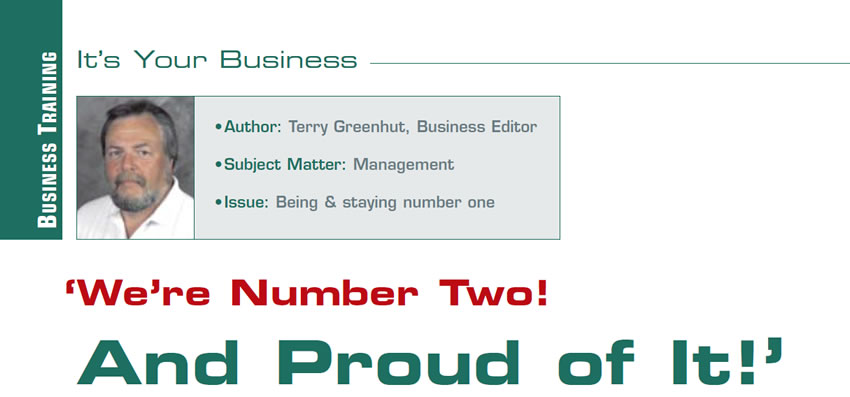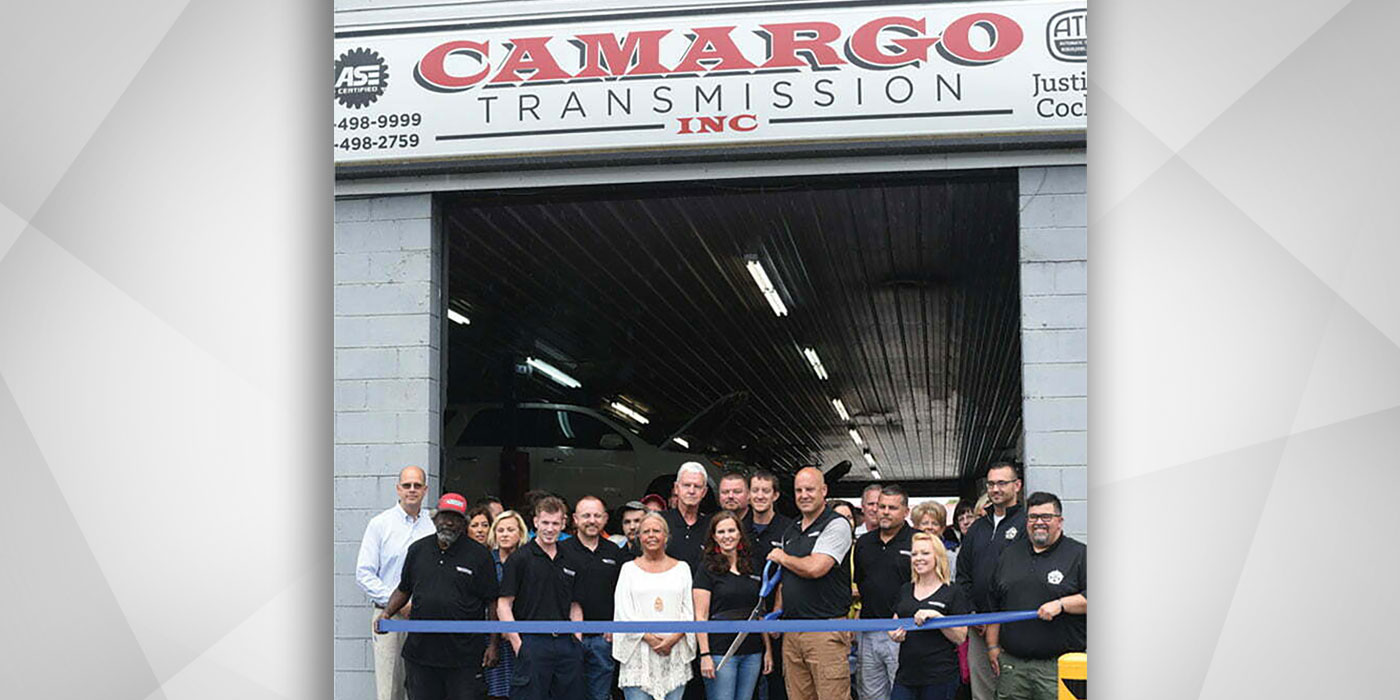
It’s Your Business
- Author: Terry Greenhut, Business Editor
- Subject Matter: Management
- Issue: Being & staying number one
Sounds really silly, doesn’t it? Other than Avis, nobody has been able to make that statement work for them. And why should it? Who wants to deal with number two if number one is available and competitive on price?
- You cannot truly be number one until your customers are.
Sure, it sounds absurd to be proud of being number two, but although most of us pay lip service to our desire to be our customers’ first choice, our actions may say otherwise. Any time you don’t make the customer your top priority, you’re tacitly agreeing not to be their top priority. You cannot truly be number one until your customers are. Being number one really is a two-way street, and it’s not an easy street. You can’t coast your way to number one – and when you get there you have to work like crazy to stay on top because you then become the target for everyone else who wants to take that title from you. If you don’t pay close attention and maintain constant vigilance you can easily backslide to number two and worse.
- There’s a considerable price to pay for maintaining your position at the top.
There’s a considerable price to pay for maintaining your position at the top. Even at those times when you know customers are “dead wrong” you have to make them right, and no matter how you feel or what kind of a mood you’re in that day, it can never show. You see, it’s not just what you’re willing to do for the customer that counts; it’s the way you go about doing it. Do it with an open heart and they will love you. Do it begrudgingly and no matter how much you’ve helped them they will feel as though you haven’t. They’ll make comments to their friends and neighbors like, “Yeah, they covered it under warranty but I could tell they weren’t happy to do it.” That’s almost as bad as not taking care of it at all.
Living and working this way is rewarding, but it’s also tough. Putting your customers’ interests ahead of your own every time can seem counterintuitive, risky and even frightening. That’s why so many businesses fail to be as competitive as they’d like. Even if they don’t realize it, they’ve chosen to operate in a way that makes it impossible for them to come in first from a customer’s perspective, and in the end all that really counts is the customer’s perspective.
- The best job security is being the best.
Especially in an uncertain economy, you can’t settle for any less than being number one, because if you do, that puts you on the road to eventual failure. Sooner or later, your vulnerability will catch up with you. The best job security is being the best.

Let’s look at the eight signs that your business is aiming lower than you may have thought, and look at some better ways to hit the bull’s-eye.
One
Your number one business goal is to make money. “Ummm … isn’t that the point of being in business?” you might be asking. Well, it’s a point, but it’s not the point. You see, a too-acute focus on improving the bottom line takes your attention off the people who are going to enable you to raise it: your customers and your employees. Your clients can always tell when they’re not your first priority, and your employees can sense when you care more about the money than their well-being.
The difference between paying attention to customer service so that your clients will give you more business and doing so because serving the customer is your first priority may feel slight, but it’s significant. Yes, taking your focus away from the bottom line may feel uncomfortable at first. But you’ll soon find that when you focus on how best to serve customers, tough decisions make themselves. The criterion is: “If it serves the customer, you do it. If it doesn’t, you don’t.” This neutralizes moral dilemmas and really simplifies your life. And it almost always has a miraculous effect on your growth and success.
Two
You let the little things slide. So, what’s the problem? Rushing through paperwork so you can get home early, failing to spell-check an email or two and running late to a meeting probably won’t matter that much six months from now. It’s the big things like growing your business, expanding your customer base, hiring more employees and making a profit that are most important, right? Not necessarily.
So often in life, it’s the small details that differentiate good from great. So be careful not to become so fixated on the forest that you fail to see the trees. In other words, don’t be so distracted by the big, grand ideas that you neglect the small details, because they are the ones your customers see. Promises kept, deadlines met, little extra flourishes and small acts of kindness add up to happy customers.
Tip: One of those little things you can do for customers whose vehicles you are keeping more than a day is to call or email them every day with a status report. It’s a huge stress reliever and an even-bigger business builder.
Three
You habitually let certain customer calls go to voicemail. It’s happened to everyone: When you see that name flash on your phone’s caller ID, you slowly pull your hand back from the receiver and let the ringing continue. You just don’t want to deal with the drama, the whining, the accusations or the belligerence just now. Yes, we all have “problem” customers. But to avoid them or just go through the motions for them is a mistake. They will notice and remember your behavior. (And be honest: Would you want to give your business to someone who might write you off when the going gets tough?)
“Customers First” has to mean all customers, not just the easy ones or the ones we like. Here’s the payoff: When you make the choice to stand by all of your frazzled, frustrated customers, you will eventually reap the financial and personal rewards. You may even become known in the community as the shop that can handle the toughest customers and situations. And, chances are, your customers themselves will be grateful that you didn’t give up on them and may even send others your way.
Four
You find yourself telling white lies. Although it’s true that telling customers white lies, or exaggerating, misdirecting or omitting, might make life easier temporarily, it’s also true that we can often justify such behavior to ourselves but these “little” lies can be just as bad as the whoppers. There is always a chance that customers will see through you and call you on the carpet. (A good chance if you don’t have a fantastic memory and can’t remember to whom you told which lie) And even if they don’t, a willingness to play fast and loose with the truth is indicative of a broader attitude of disregard for customers.
Honesty can be tough in the moment, but a reputation for trustworthiness (or untrustworthiness!) can stick with you for life. Live by a policy of never holding back or sugarcoating and you’ll gain customer loyalty that money can’t buy. Plus, when you have only the truth, you wave goodbye to moral dilemmas and sleepless nights. You don’t have to worry about getting the story straight or remembering what you have and haven’t said. You know you’re doing the right thing.

Five
You spend more time trying to get off the phone than really hearing what the customer has to say. Chances are, you roll out the red carpet to get prospective customers in the door and you’re probably willing to bear with the whims, questions and requests of fairly new customers whose business isn’t yet cemented. But what about older, more-established ones? Do you take the same amount of time and care with them, or do you assume they’ll stick with you out of habit and convenience?
If you wouldn’t hang up the phone at the first opportunity with a customer you started doing business with last week, don’t do it with one you’ve been dealing with for 10 years. Companies that become number one don’t do so because they win customers over once, but because they do it every day. A good experience last month usually won’t keep a customer coming back this month if he or she believes that your level of service has slipped.
Six
You don’t know, nor do you care to find out, very much about your customer’s life. In your eyes you’re being professional when every question in your customer interview is about the vehicle and its problems. In the customer’s eyes, however, it makes you seem very cold and impersonal – not someone with whom they would want to have a long-term relationship. Finding out about the customer’s interests, family, pastimes and financial preferences shows you as a caring individual. Remember, to truly serve you have to care. When you keep yourself at arm’s length, you can’t give your clients 100%, and you give them an incentive to take their business elsewhere.
People want to do business with individuals they like – and they like people who like and care about them! Make a deeper connection with your customers by asking about their kids, their pets, their hobbies and their jobs or businesses. You’ll find that most of them are just like you: filled with worries, hopes and dreams. Once you get familiar with and invested in these things, you’ll work that much harder on each customer’s behalf, and you’ll earn their loyalty in the process.
Seven
You believe your main obligation to employees is writing their paycheck. Although you don’t treat employees like dirt, you may feel that you don’t owe them any special favors either. After all, you’re paying them; isn’t that enough? Well, no. The way your people treat customers reflects the way you treat them. Are you courteous, kind and enthusiastic? Do you listen when they talk to you and try to accommodate their needs? Or are you short, distracted and even (sometimes) rude?
Your job is to serve others – period. That means you shouldn’t make distinctions between the people who work for you and the people to whom you provide a service. Realize that you set the tone for your company’s “personality” and that you’re creating a tribe of people who will beat the drum for your message. Try to see your employees through a customer’s eyes and be honest: Would they win first or second place in a customer-service competition? If you don’t like the answer, try adjusting your own attitude first.
Eight
You’re not above badmouthing the competition. Some business owners don’t hesitate to casually say things like: “Sure, Shop X is cheap, but the quality of their work leaves a lot to be desired,” or “I’d think twice before I took my car to Firm Y. Didn’t you hear they had to lay off half of their staff last year?” Just remember that when you sling mud at your opponent, some of it is likely to get on you, too. Besides, wouldn’t you rather rise to the number one spot solely on your company’s merits and not because you took cheap shots at the guy down the street?
In fact, you can and should strive to win the approval, goodwill and admiration of your competitors. If possible, get to know and help them when you can. You don’t have to give away trade secrets, but you can offer advice that might even make them better or fairer competition.
Remember, if you want to be and stay number one, always think like number one. In every situation ask yourself, “What would the best shop do?” And then do it, even if it hurts a little. The rewards will be there in time. That’s how you’ll stay on top.














